Gallery
- Facade and Piazza
- Atrium with Roman mosaics, entrance to Spallanzani collections
- Venus of Chiozza
- Balena Valentina
- Paleontology collection of human skulls
The Palazzo dei Musei is the civic museum located in front of Piazza Martiri del 7 Luglio, facing the Valli Municipal Theatre, in central Reggio Emilia. The collection is diverse and includes works of art, archeology, history, and natural history.
The buildings prior housed the church of San Luca and an adjacent palace, but were granted in 1256 to the Franciscan order by the then bishop Guglielmo Fogliani. The structures were converted into a monastery. During the Napoleonic occupation, the monastery was suppressed and the building became both barracks and stable.
The building also housed various schools. It was designated to display civic collections in 1830, beginning with the natural history and travel collections of Lazzaro Spallanzani, purchased by the Municipality in 1799. In 1862 the Don Gaetano Chierici began displaying another collection of local minerals, fossils, and archeologic findings.
The Marbles Gallery, established and open to the public in 1875, displaying stone mosaics, sculptures, and architectural fragments dating from Roman era to the 19th century. In addition to the Spallanzani collection there are zoologic (Antonio Vallisneri room), anatomic (Paolo Assalini room), botanical and ethnographic (Giambattista Venturi room) collections. Among the displays is the fossils of the Valentina whale (2001), a 3.5 million-year-old fossil cetacean found on the hills, were added to the 19th-century collections from the Secchia Valley.
The Antonio Fontanesi Gallery contains artworks from the 14th to the 20th century. It contains artworks collected by the Bank of Bipop-Carire. The museum has paintings and works by Antonio Ligabue, Fausto Melotti; Claudio Parmiggiani, and Marco Gerra. In 2005, the building was refurbished and restored by Italo Rota. [1]

The Uffizi Gallery is a prominent art museum located adjacent to the Piazza della Signoria in the Historic Centre of Florence in the region of Tuscany, Italy. One of the most important Italian museums and the most visited, it is also one of the largest and best known in the world and holds a collection of priceless works, particularly from the period of the Italian Renaissance.

Lazzaro Spallanzani was an Italian Catholic priest, biologist and physiologist who made important contributions to the experimental study of bodily functions, animal reproduction, and animal echolocation. His research on biogenesis paved the way for the downfall of the theory of spontaneous generation, a prevailing idea at the time that organisms develop from inanimate matters, though the final death blow to the idea was dealt by French scientist Louis Pasteur a century later.
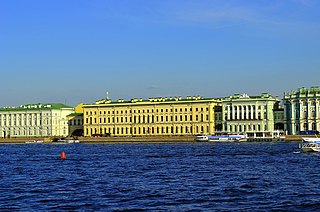

The Vatican Museums are the public museums of the Vatican City. They display works from the immense collection amassed by the Catholic Church and the papacy throughout the centuries, including several of the most well-known Roman sculptures and most important masterpieces of Renaissance art in the world. The museums contain roughly 70,000 works, of which 20,000 are on display, and currently employ 640 people who work in 40 different administrative, scholarly, and restoration departments.

Reading Museum is a museum of the history of the town of Reading, in the English county of Berkshire, and the surrounding area. It is accommodated within Reading Town Hall, and contains galleries describing the history of Reading and its related industries, a gallery of artefacts discovered during the excavations of Calleva Atrebatum, a copy of the Bayeux Tapestry, finds relating to Reading Abbey and an art collection.

The Capitoline Museums are a group of art and archaeological museums in Piazza del Campidoglio, on top of the Capitoline Hill in Rome, Italy. The historic seats of the museums are Palazzo dei Conservatori and Palazzo Nuovo, facing on the central trapezoidal piazza in a plan conceived by Michelangelo in 1536 and executed over a period of more than 400 years.

Castello Ursino, also known as Castello Svevo di Catania, is a castle in Catania, Sicily, southern Italy. It was built in the 13th century as a royal castle of the Kingdom of Sicily, and is mostly known for its role in the Sicilian Vespers, when it became the seat of the Sicilian Parliament. The castle is in good condition today, and it is open to the public as a museum.

The Museo Correr is a museum in Venice, northern Italy. Located in St. Mark's Square, Venice, it is one of the 11 civic museums run by the Fondazione Musei Civici di Venezia. The museum extends along the southside of the square on the upper floors of the Procuratorie Nuove. With its rich and varied collections, the Museo Correr covers both the art and history of Venice.

Gualtieri is a comune (municipality) in the Province of Reggio Emilia in the Italian region Emilia-Romagna, located about 70 kilometres (43 mi) northwest of Bologna and about 25 kilometres (16 mi) north of Reggio Emilia on the right bank of the Po River. Historically, it suffered numerous floods, the last occurring in 1951.
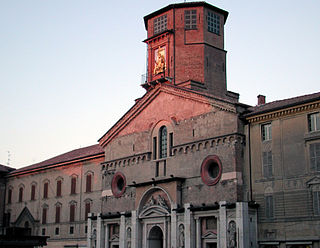
Reggio Emilia Cathedral is a Roman Catholic cathedral in Reggio Emilia. The dedication is to the Assumption of the Virgin Mary. Formerly the episcopal seat of the Diocese of Reggio Emilia, it has been since 1986 that of the Diocese of Reggio Emilia-Guastalla.
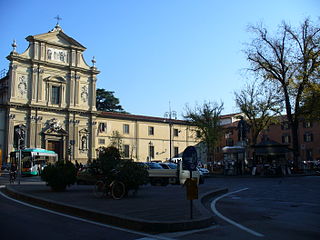
Museo Nazionale di San Marco is an art museum housed in the monumental section of the medieval Dominican convent of San Marco dedicated to St Mark, situated on the present-day Piazza San Marco, in Florence, a region of Tuscany, Italy.

The Antalya Museum or Antalya Archeological Museum is one of Turkey's largest museums, located in Konyaaltı, Antalya. It includes 13 exhibition halls and an open air gallery. It covers an area of 7,000 m2 (75,000 sq ft) and 5000 works of art are exhibited. In addition a further 25,000–30,000 artifacts which cannot be displayed are in storage. As a museum exhibiting examples of works, which illuminate the history of the Mediterranean and Pamphylia regions in Anatolia, Antalya Museum is one of the most important of Turkey's museums. The Museum won the "European Council Special Prize" in 1988.

The Museo Nazionale della Magna Grecia, Museo Archeologico Nazionale di Reggio Calabria or Palazzo Piacentini is a museum in Reggio Calabria, southern Italy, housing an archaeological collection from sites in Magna Graecia.

Gino Vinicio Gentili was an Italian archaeologist.

The Antonino Salinas Regional Archeological Museum is a museum in Palermo, Italy. It possesses one of the richest collections of Punic and Ancient Greek art in Italy, as well as many items related to the history of Sicily. Formerly the property of the Oratory of Saint Philip Neri, the museum is named after Antonino Salinas, a famous archaeologist and numismatist from Palermo who had served as its director from 1873 until his death in 1914, upon which he left it his major private collection. It is part of the Olivella monumental complex, which includes the Church of Sant'Ignazio all'Olivella and the adjoining Oratory.
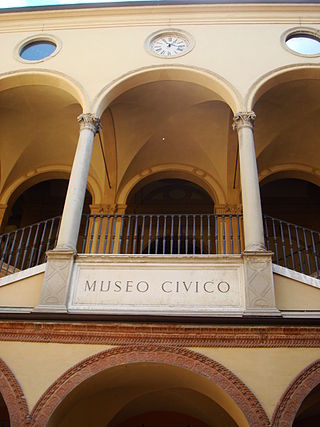
The Archaeological Civic Museum of Bologna is located in the fifteenth-century Palazzo Galvani building at Via dell'Archiginnasio 2 postal code 40124 Bologna, once known as the Hospital of Death. Founded in September 1881 by the merging of two separate museums: the one belonging to the University of Bologna – heir of the Room of Antiquity belonging to the Academy of Sciences founded by Luigi Ferdinando Marsili in (1714) – and that belonging to the City of Bologna (enriched by the antique collection of Artist Pelagio Palagi and the large amount of finds from excavations conducted in and around Bologna during these times.

The Hull and East Riding Museum is located in the Museums Quarter of the Old Town in Kingston upon Hull, England. It dates back to 1925 as the Museum of Commerce and Industry in a former Customs House but acquired its present name in 1989 with a major refurbishment and new entrance, with the transport section moving to a separate museum. It displays items from prehistoric to medieval in the area, many of them in life-size tableaux or reconstructions of rooms and buildings.
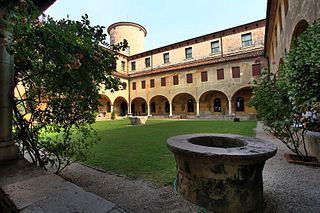
The Museo Civico di Bassano del Grappa is the town art and architecture museum located on Piazza Garibaldi #34 in Bassano del Grappa, in the Vicenza province of the region of the Veneto, in northern Italy. It is housed in a former Franciscan convent.

The Museo della Città is the civic museum located in the former Jesuit convent on Via Luigi Tonini #1 of the city of Rimini, in the region of Emilia-Romagna, Italy. It rises adjacent to Chiesa del Suffragio, and a modern structure built to enclose the ruins of an ancient Roman Domus, or house.
The Gallerie Estensi is a network of three museums and a library, bringing together the collective fruits of artistic production from Ferrara, Modena and Sassuolo in the Emilia-Romagna region of Northern Italy. The galleries aim to preserve the historic heritage left by the influential House of Este, with a focus on relating their noble past to the local communities at each site.